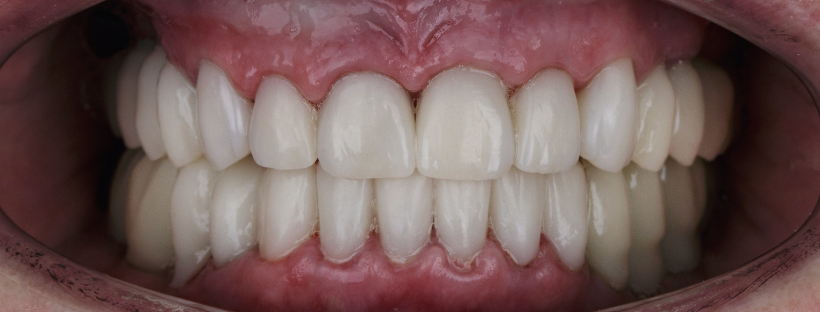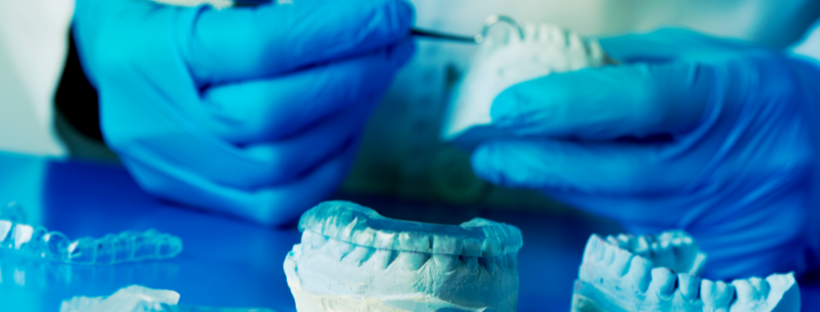All-ceramic restorations have grown in popularity due to their superior aesthetics and biocompatibility compared to traditional metal-ceramic restorations. Now, this means that 80.2% of crowns and fixed prostheses produced in the US are all-ceramic restorations, paving the way for advanced dental esthetics.
However, with the proliferation of all-ceramic dental materials, clinicians face the challenge of selecting the right material for each restoration. To address this challenge, understanding the physical and aesthetic properties of these ceramics is paramount.
This article provides a comprehensive guide on selecting appropriate all-ceramic materials based on their inherent properties. From feldspathic porcelains to the latest zirconia, this blog categorises and contrasts the myriad types of all-ceramic materials available in today’s market. It will also provide guidelines on where and when to use specific types of all-ceramic materials based on factors like patient need, anatomical location, and chewing load.
The Appeal Behind All-Ceramic Restorations
All-Ceramic restorations have the unique ability to replicate natural tooth colour and translucency, providing superior aesthetics compared to any other material available. Moreover, ceramics exhibit excellent biocompatibility, making them less likely to trigger allergic responses, and are gentle on the gums.
Ceramic restorations are also extremely strong and durable and will last for a long time if maintained correctly. Taking into account these benefits, it’s clear to see why all-ceramic restorations have rapidly gained popularity and are adopted en masse worldwide.
Types of All-Ceramic Restorations
Here are some of the most commonly used types of all-ceramic restorations in dentistry:
- Feldspathic Ceramics
Feldspathic ceramics are primarily composed of feldspar, a mineral found abundantly in the Earth’s crust. In its natural form, feldspar is a primary component in granite. When used in dental ceramics, feldspar is combined with other materials like kaolin (a type of clay) and quartz, then heated to high temperatures to produce glass.
Glass-ceramic and porcelain laminate veneers (feldspathic ceramics) boast impressive survival rates. The most common issue encountered is fracture or chipping, yet their overall reliability and ability to conserve tooth integrity underscore their efficacy as a treatment choice. Research has shown that their survival rate is similar to that of metal-ceramic crowns. Weaker Feldspathic or silica-based ceramics are best suited for use in the anterior region.
It is important to note that changes in ceramic thickness and substructure colour significantly affect the colour profile. Therefore, dentists should keep this consideration in mind. CAM/CAM fabricated ceramic crowns provide adequate marginal adaptation as well.


2. Lithium Disilicate Ceramics
Lithium disilicate ceramics are a category of dental ceramic materials that has become immensely popular due to their enhanced esthetics and boosted strength. As the name suggests, the primary crystalline structure in this ceramic is lithium disilicate. It starts as a glass-ceramic ingot and is then heat-treated to produce a material replete with these crystalline structures.
Lithium disilicate restorations can be fabricated using two primary methods: the press technique and CAD/CAM (Computer-Aided Design/Computer-Aided Manufacturing) milling. IPS e.max is one of the most recognised brand names for lithium disilicate ceramics in the dental industry. They are superior to composite crowns in terms of fracture resistance.
It is important to note that Lithium disilicate single crowns show promising survival rates in the short term, but there is limited data for their medium-term durability. As for lithium disilicate fixed dental prosthesis, short-term outcomes are decent, but medium-term results are less optimistic. Notably, most issues with these restorations arise in the posterior region of the dental arch.
3. Zirconia Based Ceramics
Amongst all the ceramics, zirconia-based ceramics exhibit high flexural strength. Monolithic zirconia boasts mechanical strengths surpassing those of traditional all-ceramic materials, effectively reducing the risk of chipping when consuming hard foods. Due to its robust structure, it has been deemed as the strongest amongst all dental ceramics.
Zirconia restorations are fabricated using a CAD/CAM machine. They are ideal for posterior crowns, bridges, implant-supported restorations, and other high-stress areas due to their superior strength. Research has shown that Implant-supported monolithic zirconia single crowns and fixed partial dentures have excellent short-term survival rates, but the evidence for medium-term survival (more than five years) and beyond is insufficient.
The demand for Zirconia in its monolithic state (especially Y-TZP) has shown a rapid increase recently. However, Zirconia, despite its excellent strength, is not the most coveted material for its mediocre esthetic properties since it lacks translucency. Newer versions have improved upon translucency drastically, making zirconia sufficiently esthetic compared to other ceramics.
To learn in detail about all-ceramic restorations, do not hesitate to enrol in our Postgraduate Diploma course, the Diploma in Aesthetic and Restorative Dentistry, where we offer you a plethora of knowledge and help you master your skills in the ever-evolving field of aesthetic dentistry.
The Pros and Cons of Using All-Ceramic Restorations
The increased popularity of All-Ceramic restorations is due to a plethora of reasons that we’ll discuss in the advantages. However, no material comes without its limitations and shortfalls. Here’s a comprehensive look at all the possible pros and cons of All-Ceramic restorations.
The Pros
Excellent Esthetics
The gold standard for esthetic restorations is all-ceramic. These materials are capable of replicating the colour, translucency, and optical properties that make them the most popular choice for restorations. Metal restorations often exhibit the silver/grey band at the level of the gumline where metal is exposed; this can be an aesthetic challenge for most people. However, with ceramics, this is not a concern since the restoration margins are also uniformly tooth-coloured.
Biocompatibility
Ceramics possess excellent biocompatibility since they are machined by modern technology to fit the tooth perfectly. This protects the tooth and its surrounding tissues, including the gums and bone. Moreover, the risk of allergies and sensitivities is significantly reduced due to the absence of a metal framework.
Thermal Properties
Compared to metals, all-ceramic restorations are poor conductors of heat and cold, hence protecting the patient and tooth against drastic temperature changes.
Conservation of Tooth Structure
All-ceramic restorations require minimum tooth preparations compared to the metal of porcelain fused to metal restorations requiring considerable tooth reduction. This is because the ceramics are thin but still have sufficient strength to support the restoration.
Stain Proof
Most ceramics resist staining and maintain their appearance for extended periods. This ensures they retain their aesthetic appeal over time.
Superior Bonding
Ceramics can be adhesively bonded to the tooth structure, which enhances retention, reduces leakage, and inhibits the risk of secondary caries.


Advance your career by studying for a world-leading postgraduate diploma
Study at the cutting-edge of dental research with curricula taught by global experts and an online schedule that suits you.
The Cons
Brittleness
Ceramics are inherently brittle materials that can fracture under excessive load if not properly fabricated or cemented.
Difficult to Repair
In the case of a fractured all-ceramic restoration, there aren’t many options for repair since it isn’t an easy material to repair. Most circumstances require a complete replacement, which means increased visits to the dental office and increased costs.
Wear of Natural Teeth
Ceramic teeth can wear down natural teeth if they oppose each other directly.
Cost
Due to technique sensitivity, all-ceramic restorations have a higher production cost than other restorations. This is due to the need for a skilled ceramist with the expertise to deal with all-ceramic restorations and achieve the desired esthetics. All-ceramic restorations also require expensive equipment like a CAD/CAM machine.
Limited Application
Due to reduced strength and high brittleness, their use in high-load areas is limited, e.g., in patients with bruxism.
Chipping
All-ceramic veneers are extremely thin at the edges and run the risk of getting chipped under unusual stress.
Consideration Checklist For All-Ceramic Restorations
Mentioned below is a list of considerations that are to be taken into account when planning an all-ceramic restoration for your patients:
Aesthetic Considerations
Aesthetic considerations play a pivotal role in determining the best restorative choices. One of the primary aesthetic factors is the inherent colour of the tooth structure. This natural shade can vary among individuals and even among teeth in the same dental arch, influencing the overall appearance and integration of restorations.
Additionally, the translucency of neighbouring teeth is of equal significance. A restoration that doesn’t match the translucency of adjacent teeth might stand out, detracting from the natural and harmonious appearance desired in dental procedures. Hence, understanding and matching both the tooth’s underlying colour and the translucency of surrounding teeth is crucial for achieving optimal aesthetic results.
Patient Considerations
When patients express a preference for metal-free restorations and prioritise aesthetic appeal, a comprehensive assessment is imperative to determine the suitability of all-ceramic solutions. Foremost in this evaluation is the integrity of the tooth. The tooth integrity is gauged by examining how much of the original tooth structure remains. This aspect can significantly influence the choice and success of the restoration.
Tooth Locus
The position of the tooth within the dental arch plays a pivotal role. It’s essential to discern whether the tooth in question occupies the esthetic zone, which primarily concerns appearance, or the functional zone, where durability and structural integrity might be more important.
Habits
Understanding the patient’s habits, especially any parafunctional behaviours like bruxism, is vital. Such habits can exert additional forces on the restorations, potentially compromising their longevity and function.
Occlusal Considerations
Factors such as tooth loss, the closeness to the temporomandibular joint, and discrepancies in the occlusal plane can increase the stress on a dental prosthesis. Historically, porcelain-fused-to-metal (PFM) crowns ensured durability despite occasional bonding challenges. However, PFMs typically demanded significant tooth reduction allow space for at least 0.3 mm of metal coping and 0.7 mm of veneering porcelain, potentially sacrificing aesthetics.
This paved the pathway for Zirconia, which is now considered a contemporary solution that dispenses with the grey metal layer. It blends strength with superior aesthetics. While early zirconia crowns had their share of bonding issues, improved lab techniques have made these failures rarer.


The Way Forward
In conclusion, the evolving landscape of dental restorations underscores the importance of matching material advancements with clinical needs. As patients today increasingly prioritise aesthetics and metal-free options, the dental community’s understanding and application of materials, especially all-ceramic alternatives, has become essential. As dental professionals, it is our duty to educate and guide our patients throughout the different stages of their journey.
The interplay between occlusal forces and restoration longevity further highlights the need for informed choices. While historical practices, like PFM crowns, have served well, innovations like zirconia-based solutions herald a new era of dental restoration. As the field continues to progress, it’s imperative for practitioners to stay abreast of these advancements, continually aligning practice with innovation for the best patient care.
Sign up to unlock more dentistry resources
Enrol now to on one of our postgraduate level diploma programmes to enhance your skills, access exclusive resources, join our global community, and more.
Master the Art of All-Ceramic Restorations at LDi
Venture into the world of all-ceramic restorations, a domain where precision, aesthetics, and functionality converge. Our Diploma in Aesthetic & Restorative Dentistry allows you to navigate through intricate topics such as ceramic material selection, cementation protocols, and the vital principles governing tooth preparation. For those eager to grasp insights at a glance, our blog has got you covered.
We take immense pride in interweaving rigorous scientific insights with hands-on applications, giving you a comprehensive grasp of the subject matter. Whether you’re an emerging dental practitioner or a seasoned veteran aiming to update your repertoire, our curriculum offers an extensive investigation into the nuances of all-ceramic restorations.
Take the next step in your career and enrol in the Diploma in Aesthetic and Restorative Dentistry. Find out more, or speak to an enrolment advisor, here.



